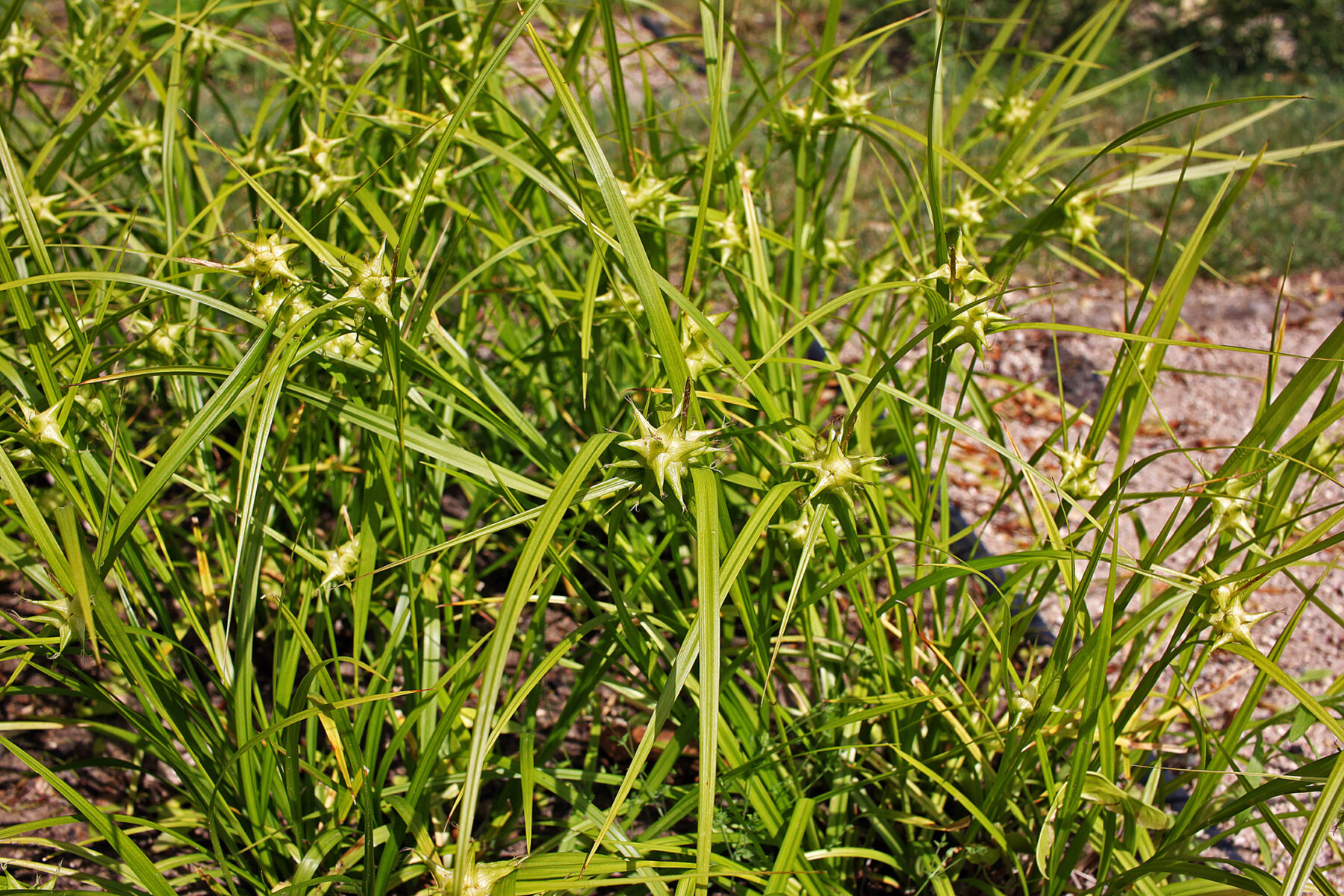Garden Musings: The Problem of Yellow Nutsedge

As the Landscape Writer, my gardens and lawn are my sanctuaries. I walk to my gardens to pray, meditate, and nurture.
But do you know what steals my joy every time?
Weeds.
Weeds are like dust in my home—never-ending. I’ve spent lots of time weeding on a muggy July day, only to find that more weeds popped up while weeding.
I find yellow nutsedge to be the worst weed of all. It’s a stubborn weed that grows like grass, but it’s yellow-green and reedy as it grows.
It ultimately looks out of place with the rest of my green lawn. It doesn’t even complement the green weeds that blend into my turfgrass.
Nutsedge propagates through seed, nutlets, and rhizomes (found in the roots).
I refuse to use chemicals to destroy it because I want the rabbits, birds, and bees to find a home that won’t kill them on my lawn and in my gardens.
I’ve aerated my lawn (with my landscape designer son) and added more grass seed to crowd out the nutsedge. And it’s worked somewhat—but it doesn’t clear up the problem.
So, I’m taking my nutsedge elimination game up a notch. I’m adding a rain garden in the part of my lawn with poor drainage. Nutsedge loves poor drainage.
I’m hoping the rain garden my landscape designer son will be building this spring will keep the nutsedge away—especially since we’ll be installing landscape fabric to suppress any more obnoxious weeds from emerging.
Nutsedge has a strong will to survive and thrive, no matter how much I despise it. It’s hard to weed to get rid of because of its persistence in reproducing through its roots, seed heads, and nutlets.
You Have Nutsedge If …
Nutsedge, also known as nutgrass, is a persistent weed that can take over your lawn, landscaped areas, and vegetable gardens. It thrives in compacted soil or poor drainage areas.
And it’s a persistent weed that’s hard to get rid of. Pulling up nutsedge feels like an endless game of whack-a-mole.
See why I get frustrated? Nutsedge wins—especially since I’m surrounded by farmland where I can’t control the field weeds.
Do you have the same nutsedge problem as I do? Do you feel like you’re losing the battle between you and nutgrass?
Best Practices to Solve the Nutsedge Problem in Your Yard
You first need to know what’s causing your nutsedge problem. Usually, it starts with poor drainage or compact soil (if you have clay). Here are three tips to get you started on your nutsedge-elimination project:
- Solve your yard drainage problem. Nutgrass predominately grows in poor drainage in my front yard, so I want a rain garden to stop the water from ponding on my lawn. I’ll put in plants that don’t mind wet feet, and that will attract more pollinators into my yard.
My landscaper son will add river stones that will be the focal point and allow the water to drain through them.
- Treat nutsedge with herbicides, but only use weed control specifically made to eradicate nutsedge. Weed killer for grassy weeds, like crabgrass, won’t get rid of nutgrass.
And, you don’t want to use a broad-spectrum weed killer that contains glyphosate or imazapyr because they’ll kill your turfgrass, your nutsedge, and every plant sprayed with it.
Be careful with weed control products because they stay in the soil and harm the soil’s ecosystem necessary for a vibrant lawn and landscape. Ultimately, your goal should be a healthy lawn rather than a perfect one if you want a sustainable yard.
Try to use organic herbicides that won’t harm the good critters in the soil. And always follow the manufacturer’s directions to a tee.
- You can rent an aerator or hire a lawn service to aerate your lawn to relieve soil compaction. Aeration should only be done every other year. It’s a natural lawn care solution that uses an aerator to pull up plugs of soil.
Aeration allows the soil to breathe—releasing carbon dioxide and allowing oxygen to penetrate the soil.
And aeration improves the soil, making it looser to receive grass seed, fertilizer, and water. You’ll find that you have fewer weeds when you aerate your soil.
We’ll talk about the many benefits of aeration in future blogs.
What about Yellow Nutsedge in the Garden?
My garden is my refuge that puts my mind and soul back together. After a stressful workday, I head to my garden—sometimes to walk around it—watching bumble bees, hummingbird moths, and hummingbirds dance on the bee balm, milkweed, and coneflowers in my flowerbeds.
I don’t see much nutsedge in my flowerbeds. Maybe a stalk or two, which I pull out. However, a part of my vegetable garden sits low where the nutsedge pokes its head out of the ground.
Over the years, as I added mushroom mulch and worked the soil, my nutgrass problem resolved itself. In that part of my garden, there needed to be better drainage and aerated soil to improve conditions.
Mushroom mulch saved the day. I pulled up the nutsedges and gradually worked the mushroom mulch into the dirt. I also revamped that part of my garden from a weedy mess into an extension of my vegetable garden.
While I still get some nutgrass in my garden—it isn’t taking over the vegetables I planted in early spring.
While my garden is too small to aerate, and I have beloved perennials in part of my veggie garden (the landscape son hates how I’ve ruined his garden design with flowers and strawberries), I could rehab the soil using mushroom mulch, which is used horse manure.
I also have a compost bin that provides garden gold for me every year. It’s another gardening success story. But that homemade compost helped naturally aerate the garden soil where nutgrass wasn’t welcomed anymore.
I’ll talk more about composting in future blogs.
Key Takeaways
Weeding is frustrating. While you may be new to gardening—don’t let the weeding chore overwhelm you by pulling weeds as you see them. Remember, Rome wasn’t built in a day, and weeding means the soil needs rehabilitation.
Here are key takeaways to encourage you in your gardening efforts:
- Try to use the most natural means of limiting weeds by adding a rain garden and reworking the soil using compost.
- Get rid of perfectionism. No lawn or garden is perfect unless it’s the only thing you have to do daily. I know of no gardener in my life who has that much time.
- Look at your lawn and gardens as laboratories. You get a chance every spring to try something new to keep your beds and lawn tidy.
Do you like this type of gardening blog? Send me an email at wendy@landscapewriter.com to tell me about your gardening needs and frustrations.
Happy Gardening!







